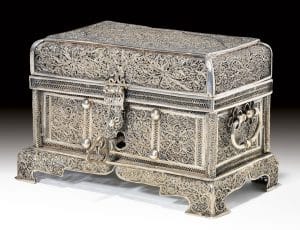Not only is The Silver Age: Origins and Trade of Chinese Export Silver a useful companion to the Hong Kong Maritime Museum exhibition of the same name, the catalog has enough material, extending well beyond the exhibition, to be a valuable volume in its own right.
The exhibition, and the catalog—the first half of which follows it closely—provides a clear artistic, cultural, historical and commercial narrative of the development of Chinese export silver, that is, silver goods manufactured in China for markets in the West. The story starts with the silver inflows—China had limited silver of its own—from, in particular, Spanish America via the so-called Manila Galleon trade. There are examples of Spanish and Mexican coinage side-by-side with Chinese silver ingots. The history of Chinese smelting and silverwork is then briefly covered, with examples dating back a millennium or more. The book contains a very clear description of each of the various techniques, from filigree to chasing and repoussé.
The narrative broadens out with the parallel investigations into the commercial and artistic development of Chinese export silver. Although some, particularly 19th century, pieces are meant to be copies of contemporary Western pieces, there was from the beginning of the industry considerable artistic feedback from the demand for “chinoiserie”—a fashion, although some might call it a fad—which picked up steam in the 17th century. Silver came along a bit later than, for example, porcelain, silk and furniture; it is evident that when silverware began to be developed as an export product, there was demand for it to be “like that”. The result was a fusion of Western models with Chinese designs and embellishments—and not, it seems, merely these. Influence can also be traced to Batavia in the then Dutch East Indies.

The filigree is particularly intriguing. While filigree itself was, as a technique, well-known and widely employed, the exhibition includes a mid-17th century casket with designs that look straight out of work from the Mediterranean. Later in the catalog there is a photograph of a not-dissimilar Qing dynasty silver filigree vase from the Palace Museum which was, it says, manufactured by Muslim craftsmen.
These first pieces were probably directed more at European nobility than as commercial items. The catalog includes a photo of Catherine the Great’s Chinese-made silver toiletry set kept at the Hermitage.

The bulk of the exhibition and hence the first part of the catalog as well deals with 19th- and early 20th-century pieces. There are teapots, of course, lots of teapots, and tea sets, but also trays, trophies, plates, dinnerware and various pieces of paraphernalia ranging from wine coasters, to bric-à-brac and card-holders. While not denying their appeal as objets d’art, these were commercial pieces. Hong Kong got in on the act as soon as it could in the mid-19th century; one Hong Kong silver shop—Wang Hing—even became a supplier to Tiffany. The catalog reproduces a number of quaint newspaper advertisements. One for Wang Hing in the China Mail from 1929 says the company’s “prices are competitive whilst the goods are above average quality.”
One would expect (sometimes, it must be said, vainly) a catalog to contain high-quality reproductions of the exhibits. This one thankfully does not disappoint: the pieces themselves are beautiful; this collection of photos, from the exhibition and beyond, is as well. The annotations are clear and informative, as is the accompanying text. This first part of the catalog does not go much beyond the exhibition, which itself is well-annotated, but the information seems easier to absorb in book form.

The second half of the catalog comprises a collection of “essays”—perhaps more accurately termed “papers”—which provide a fuller and more academic background to various aspect of the subject. The first of these by Japanese academic Kuroda Akinobu provides the clearest overview I have yet read of not just the financial use of silver in China, but also of Chinese monetary instruments in general. It remains a mystery why China didn’t have a successful silver coinage until the late 19th century, and that was one based on the Mexican dollar. It was not that China hadn’t ever had silver coins, but they never took. Kuroda notes that in China, copper was used to “mediate daily exchanges” while silver was for such fiscal purposes as “settling long-distance trades”. For a long time, silver did not compete with copper; it competed with silk as a medium of exchange. Paper money could be denominated in silk as late as the 13th century.
The Maritime Museum’s own Libby Chan contributes a paper of the artistic origins of Chinese silverware, providing more detail on themes hinted at in the exhibition. It is not in retrospect surprising that influences came from all over, China itself, the West and other places like Dutch-ruled Batavia, but it nevertheless worth reflecting that this was the first time in history that such global fusion was or could have been practiced. Chinese export silver provides visual examples of the globalization we know take for granted.
Susan Eberhard of the University of California at Berkeley closes the book with a fascinating paper on such things as Chinese imitations of British hallmarks, which yield an almost philosophical discussion of the nature of authenticity and value, a question which—in the form of trademarks, brands and intellectual property—still shadows international trade between China and the West.
Between these are other papers on silver exchanges between Western embassies and the Qing Court, and narrower looks at both Guangzhou and Hong Kong Silver.
This bilingual volume appeals, as an exhibition catalog should, to the eye and the mind and contains more than enough additional information and analysis to qualify as a stand-alone volume. It is marred only by less-than-thorough copy-editing on the English side: nothing that deter communications, but prose, like silver, needs polishing before it shines.
The Silver Age: Origins and Trade of Chinese Export Silver deserves a wider circulation that one suspects it will get.

